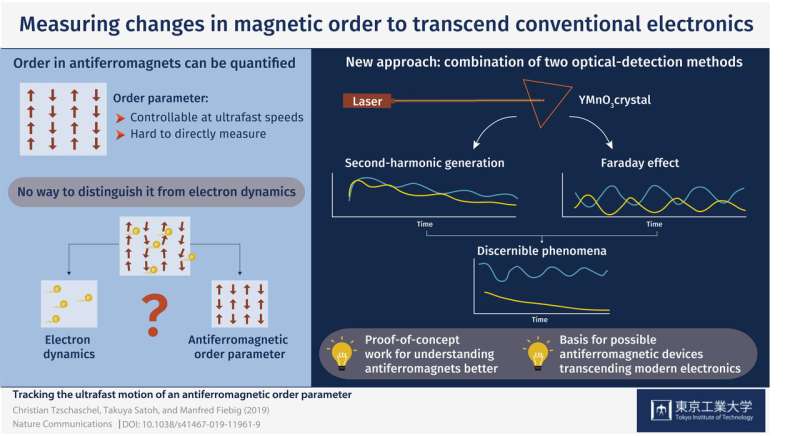Measuring changes in magnetic order to find ways to transcend conventional electronics

Researchers around the world are constantly looking for ways to enhance or transcend the capabilities of electronic devices, which seem to be reaching their theoretical limits. Undoubtedly, one of the most important advantages of electronic technology is its speed, which, albeit high, can still be surpassed by orders of magnitude through other approaches that are not yet commercially available.
A possible way of surpassing traditional electronics is through the use of antiferromagnetic (AFM) materials. The electrons of AFM materials spontaneously align themselves in such a way that the overall magnetization of the material is practically zero. In fact, the order of an AFM material can be quantified in what is known as the 'order parameter.' Recent studies have even shown that the AFM order parameter can be 'switched' (that is, changed from one known value to another, really fast) using light or electric currents, which means that AFM materials could become the building blocks of future electronic devices.
However, the dynamics of the order-switching process are not understood because it is very difficult to measure the changes in the AFM order parameter in real time with high resolution. Current approaches rely on measuring only certain phenomena during AFM order switching and trying to obtain the full picture from there, which has proven to be unreliable for understanding other more intricate phenomena in detail. Therefore, a research team lead by Prof. Takuya Satoh from Tokyo Tech and researchers from ETH Zurich, developed a method for thoroughly measuring the changes in the AFM order of an YMnO3 crystal induced through optical excitation (that is, using a laser).

The main problem that the researchers addressed was the alleged "practical impossibility" of discerning between electron dynamics and changes in the AFM order in real time, which are both induced simultaneously when the material is excited to provoke order-parameter switching and when taking measurements. They employed a light-based measuring method called 'second-harmonic generation,' the output value of which is directly related to the AFM order parameter, and combined it with measurements of another light-based phenomenon called the Faraday effect. This effect occurs when a certain type of light or laser is irradiated on magnetically ordered materials; in the case of YMnO3, this effect alters its AFM order parameter in a predictable and well-understood way. This was key to their approach so that they could separate the origin and nature of multiple simultaneous quantum phenomena that affected the measurements of both methods differently.
Combining these two different measurement methods, the researchers managed to fully characterize the changes in the AFM order parameter in real time with ultrafast resolution. "The proposed general approach allows us to access order-parameter dynamics at timescales of less than one trillionth of a second," states Prof. Satoh. The approach presented is crucial for better understanding the inner workings of antiferromagnetic materials. "Precise and thorough tracking of the variations in the order parameter is indispensable for understanding the complex dynamics occurring during ultrafast switching and other AFM-related phenomena," explains Prof. Satoh. The tool provided by the researchers should now be exploited to carry out more research and hopefully bring about the development of revolutionary electronic devices with unprecedented speeds.
More information: Tracking the ultrafast motion of an antiferromagnetic order parameter, Nature Communications, DOI: 10.1038/s41467-019-11961-9
Journal information: Nature Communications
Provided by Tokyo Institute of Technology



















